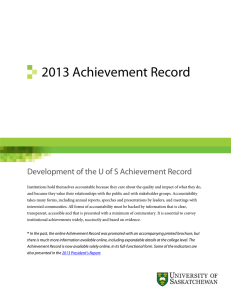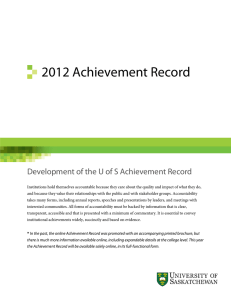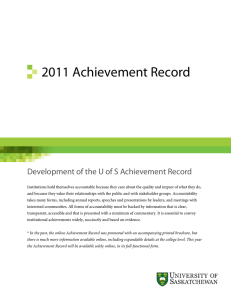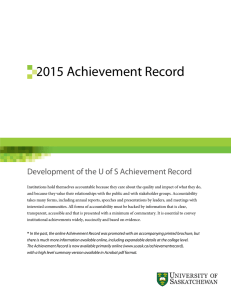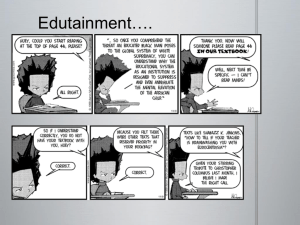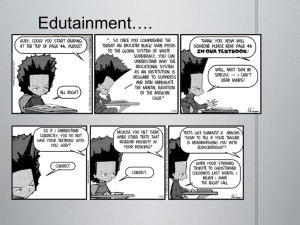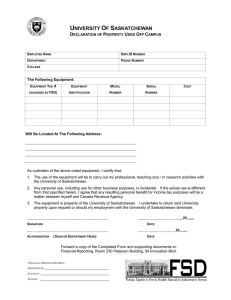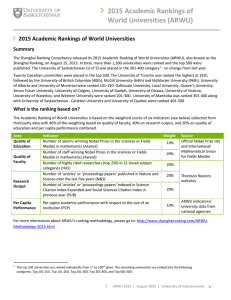2014 Achievement Record Development of the U of S Achievement Record
advertisement
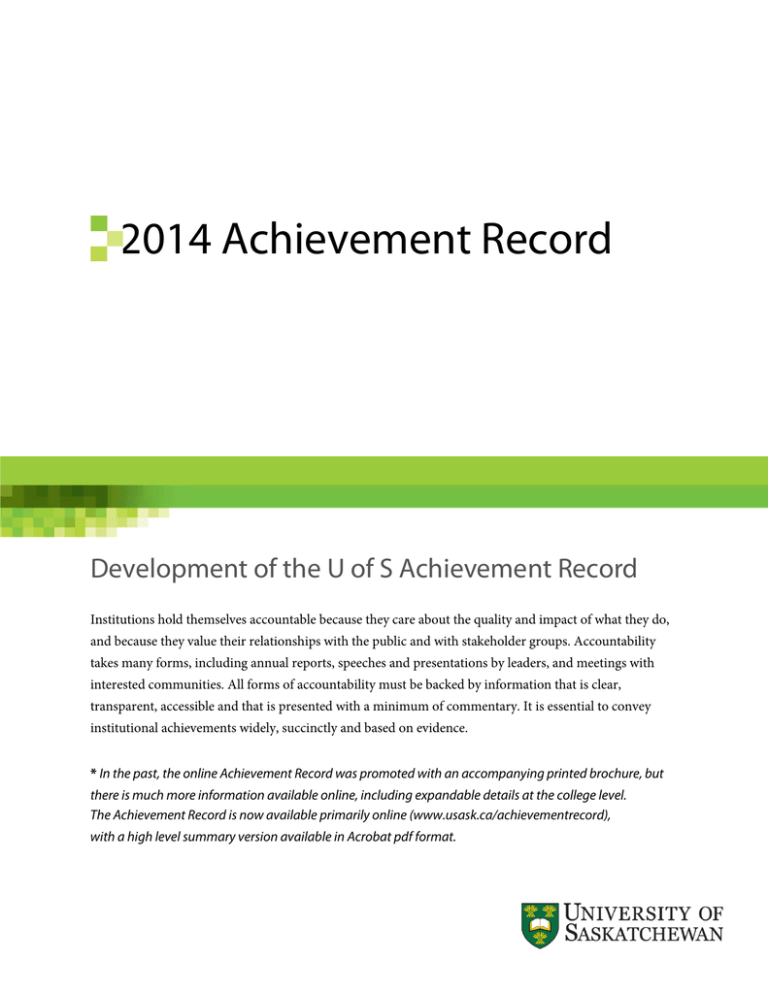
2014 Achievement Record Development of the U of S Achievement Record Institutions hold themselves accountable because they care about the quality and impact of what they do, and because they value their relationships with the public and with stakeholder groups. Accountability takes many forms, including annual reports, speeches and presentations by leaders, and meetings with interested communities. All forms of accountability must be backed by information that is clear, transparent, accessible and that is presented with a minimum of commentary. It is essential to convey institutional achievements widely, succinctly and based on evidence. * In the past, the online Achievement Record was promoted with an accompanying printed brochure, but there is much more information available online, including expandable details at the college level. The Achievement Record is now available primarily online (www.usask.ca/achievementrecord), with a high level summary version available in Acrobat pdf format. Teaching, Learning and the Student Experience Students Total number of undergraduate students in each year Student Cohort Aboriginal International 2010/2011 1,787 901 2011/2012 1,748 1,013 2012/2013 1,886 1,108 2013/2014 2,082 1,175 Note: Student headcounts from previous years have been restated to include retroactive adjustments in registration activity. Teaching, Learning and the Student Experience 2 Total number of graduate students in each year Student Cohort Aboriginal International 2010/2011 162 844 2011/2012 177 990 2012/2013 207 1,140 2013/2014 241 1,210 Note: Student headcounts from previous years have been restated to include retroactive adjustments in registration activity. Teaching, Learning and the Student Experience 3 Instructional Activity Number of three credit unit equivalent registrations (3CUE) in each year Note: Instructional activity from previous years has been restated to include retroactive adjustments in registration activity. Teaching, Learning and the Student Experience 4 Student Completion Rates Percentage of first-time, full-time direct entry students who graduated within a six-year time frame Note: The cohort definition for student completion rates has been modified to follow CSRDE (Consortium of Student Retention Data Exchange) standards (see http://www.usask.ca/achievementrecord/teachinglearning/student-completion-rates-definition.php). * Entry and final year of the six-year time frame shown on the graph. Teaching, Learning and the Student Experience 5 Overall Satisfaction Percentage of students who responded favourably to questions about their overall quality of education/evaluation of their entire educational experience Teaching, Learning and the Student Experience 6 Learning Outcomes In progress According to the University of Saskatchewan (U of S) Learning Charter(2010), achieving the learning vision and goals to which we aspire requires the active commitment of students, instructors, and the institution. In the Third Integrated Plan, Promise and Potential, we have set the goal of having defined learning outcomes for all undergraduate and graduate programs by 2016. Considerable activity designed to reach this goal was undertaken in 2012-13. In its first full year of operation at the Gwenna Moss Centre for Teaching Effectiveness, the Curriculum Development Group worked with 12 colleges, 3 schools, 46 departments and the Library on aspects of curriculum development and instructional design. Learning outcomes in professional colleges are closely tied to accreditation requirements. Program- and college-level learning goals (also called learning assurances, degree expectations) are evident in all of the direct entry colleges (Agriculture and Bioresources, Arts and Science, Edwards School of Business, Engineering, Kinesiology). Similarly, the College of Graduate Studies and Research has established learning outcomes for each of the four graduate degrees (PGD, PGDSC, Master’s, and Doctoral). There is clear alignment and overlap between the articulation of program-level learning goals within colleges and the core goals outlined in the Learning Charter. Work in moving from a higher level of goals to learning outcomes at the departmental level (where appropriate) continues. Some colleges (e.g. Engineering and Arts and Science), have advanced to the stage of creating and piloting assessment rubrics for the purpose of evaluating whether learning outcomes are being achieved. Teaching, Learning and the Student Experience 7 Research, Scholarly and Artistic Work External Funding for Research, Scholarly and Artistic Work Total and Tri-Agency Research Revenue Revenue Source All Other Tri-Agency Total 2010/2011 $155,606,333 $50,987,913 $206,594,246* 2011/2012 $117,354,880 $50,406,262 $167,761,142* 2012/2013 $119,453,130 $39,012,692 $158,465,823* 2013/2014 $157,425,000 $38,223,211 $195,648,211* * Please note: The totals above are based on Financial Services Division published research revenue data. University of Saskatchewan research revenue amounts in the CAUBO reports used in the benchmarks for peer data are based on a unique definition of research revenue and vary from the above totals by a small amount. Research, Scholarly and Artistic Work 8 Faculty Awards and Honours Number of prestigious awards received by U of S faculty based on national and international awards and honours over a four-year period Research, Scholarly and Artistic Work 9 Output and Impact Academic Ranking of World Universities (ARWU) Commonly known as the Shanghai Ranking 2013/2014 University of Saskatchewan ARWU Ranking 301-400 University of Saskatchewan Scores on ARWU Indicators * The U of S received a score of zero for this indicator in the ARWU. As a result, this indicator cannot be displayed on the graph. Research, Scholarly and Artistic Work 10 Working Together Faculty and Staff Engagement Percentage of U of S faculty and staff who responded favourably to questions in the annual Employee Opinion Survey about their level of engagement Working Together 11 Administrative Efficiency Administrative Cost Ratio Administrative and general expenses as a percentage of total expenditures * Data for 2013/2014 is pending the release of data by CAUBO (Canadian Association of University Business Officers). Working Together 12 Diversified Revenues Monetary donations received by the U of S Working Together 13 Campus Sustainability U of S Rating on STARS (Sustainability Tracking, Assessment and Rating System) 2012/2013 University of Saskatchewan Overall STARS Rating Bronze *Please note: Dalhousie University, the University of British Columbia and Western University data is from 2010/11. McGill University data is from 2011/2012. University of Ottawa, University of Saskatchewan, University of Alberta and University of Calgary data is from 2012/13. STARS Categories Education and Research Operations Planning, Administration and Engagement Category Average Innovation Credits Overall Score = Category Average + Innovation Credits Working Together 2012/2013 Total Possible Credits U of S Category Score 100.00 23.7% 99.75 24.7% 99.75 51.0% 99.83 33.1% 4.00 4.00 104 37.1 14 An Engaged University Engagement Partnerships Current number of (a) research partnerships with external partners, (b) centres, (c) existing articulation agreements and (d) experiential learning initiatives and internship programs. Research Partnerships with External Partners Experiential Learning Initiatives and Internship Programs, Existing Articulation Agreements, and Centres * Improved tracking of experiential learning initiatives and internship programs has resulted in a significant increase from last year. An Engaged University 15 National Reputation Ranking of the U of S among 15 medical/doctoral institutions in Canada according to Maclean’s University Rankings * In previous years, rankings that were published on the Achievement Record website were based on our placement in the Maclean’s reputational survey only. Survey responses were gathered from university officials, high school principals and guidance counselors, CEOs and corporate recruiters across Canada. This year’s Achievement Record uses the overall ranking from all six indicators instead, as it provides a more holistic measurement of the reputation of the U of S. An Engaged University 16 Aboriginal Community Aboriginal Student Success Number of self-identified Aboriginal students who have graduated in each calendar year Level Graduate Undergraduate 2010 2011 2012 2013 28 31 39 63 250 253 276 336 * 2014 graduation data available in December, 2014. An Engaged University 17 Aboriginal Faculty and Staff Percentage of faculty and staff who have declared Aboriginal ancestry (based on a sample of 2,600 employees in 2013/2014) * Self-declared Aboriginal faculty and staff increased in part due to a campaign for self-declaration. The sample of 2,600 employees is as of 2013/2014. An Engaged University 18 Principles of the U of S Achievement Record 1. The Achievement Record should be widely discussed and collaboratively used. 2. The Achievement Record should support multiple purposes. 3. To serve its varied purposes, the Achievement Record should be simple. 4. Indicators ought to measure, as much as practical, the things that are meaningful or important to the organization. 5. Initially, the University of Saskatchewan should focus on a practical initial set of indicators, leaving more elaborate development for later if needed. We are working toward becoming an engaged university. Many of the indicators of our success require further development as part of our commitment to quality and accountability. 2014 Achievement Record 19
